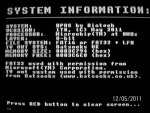ChedderCheeser
Senior Member
Hi all, I was wondering, is is possible to display.. stuff on a tv using the yellow, 2 wire, coax. cable? I am using a picaxe 08M and will run it at 8MHz if needed. I want to have and use a O8M2, but I dont have one. I know its faster, and thats why. But yea, ... I always wondered how you can get VIDEO from 2 wires... Can someone explain this to me PLEASE?  Also, if there is some example code.. that would be nice. I'm sorry if I'm asking much of you all... I just was wonderin.
Also, if there is some example code.. that would be nice. I'm sorry if I'm asking much of you all... I just was wonderin.  THANKS!!!
THANKS!!!

